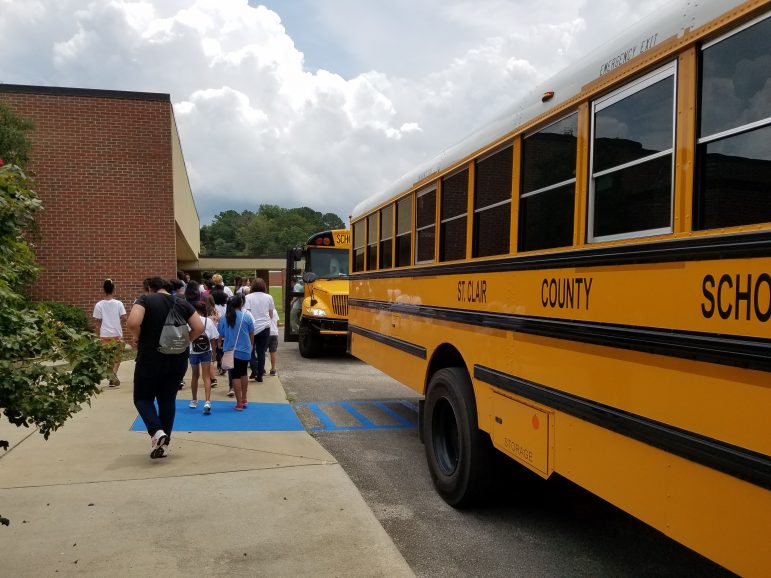By Mary Sell
Alabama’s teacher shortages are reaching crisis level, education leaders say.
In the 2017-2018 school year, there were more than 1,700 teachers in grades seven through 12 who were not certified to teach the English, math, social studies, science or special education classes they were assigned, said Ryan Hollingsworth, executive director of School Superintendents of Alabama. Some of those teachers may have a one-year emergency certificates or are “teaching out of field,” meaning they’re certified in other subjects.
“I would call it a crisis that today we’re sending children to schools where 1,700 teachers aren’t certified in the subject they’re teaching,” Hollingsworth told BirminghamWatch recently.
There aren’t enough new teachers in the pipeline, Hollingsworth said. The state’s education colleges recently graduated just more than 500 new educators to teach the core subjects that are being taught by more than 1,700 uncertified teachers.
“We’re seeing fewer people go into education for various reason,” he said. “It’s a crisis.”
While data on how many more teachers are needed in Alabama and other states is often hard to find, a task force put together by the Alabama State Department of Education is trying to get a grasp of the problem, its causes and possible solutions. Findings will be shared with the Alabama Legislature.
“We’re trying to make a point to legislators that we have an issue and we’re going to need to address it in the next couple of years,” Hollingsworth said. “And they know it.”
State Superintendent Eric Mackey put together the panel. It met late last month to discuss where the shortages are and what barriers are keeping people from becoming teachers.
From 2009 to 2015, the enrollment of education majors at Alabama’s public universities dropped by 19 percent, according to the Alabama Commission on Higher Education.
In 2017, Gov. Kay Ivey said there were hundreds of math and science teachers who weren’t certified in at least one of the classes they were teaching. She pushed for $325,000 in scholarship money for potential math and science teachers in the 2019 education budget. This year, that amount was increased to $725,000.
“Superintendents are doing the best they can (to find teachers)” Mackey said. “There just are not enough people out there to do it.”
Worse in rural areas
“(The shortage) is crisis level in places, especially in rural areas,” Mackey said. He said the Perry County school system has only one certified high school math teacher.
“People are not relocating to these rural communities,” Mackey said. “They’re simply commuting until they get a job closer to home.”
Data on the shortage by school systems isn’t readily available. The State Department of Education did give BirminghamWatch a spreadsheet that showed shortages by district and subject areas for the current year, but 55 of 137 systems statewide hadn’t reported data to the ALSDE. Of the 83 that did, all but four reported shortages in at least one subject. Math topped the list.
Some city systems are also struggling. Montgomery Public Schools, which covers the city and county, has open positions “and there are not applicants,” Mackey said.
The U.S. Department of Education lists reported shortages by state and subject area, going back to 1990. According to it, Alabama had shortages in special education at all grade levels in 1990 through 1999.
By 2017-2018, the list of subjects had expanded to include middle and high school arts courses, English and language arts, foreign languages, history and social sciences, math and science.
“It is a crisis of proportion, and it’s going to get worse if we don’t intervene pretty quickly,” Mackey said.
Elementary teachers becoming harder to find
Teacher shortages in high school math and science aren’t a new problem. Systems for years have looked for creative ways to fill these posts. But now, even elementary classrooms are getting harder to staff.There are enough elementary teachers, but there is not a surplus, Mackey said.
Before becoming head of the superintendents’ association last year, Hollingsworth was the head of Marion County Schools for 10 years. In his last year, he said, he had three elementary teachers out on maternity leave.
“I had a hard time finding teachers to fill (those positions),” he said.
Mackey said postings for elementary school teaching positions used to get as many as 60 applications, but now they get five or six in some systems.
Again, the problem is worse in more remote parts of the state. Some rural superintendents have only one or two teacher applicants to choose from for positions.
When the task force meets again later this month, it will discuss teacher recruitment and possible alternative paths to get more people qualified to teach. Other topics, and conversation with state leaders, will follow.
“I would think it would be a crisis when our leadership wants us to be competitive with other states,” Hollingsworth said of the shortages. “How can we be competitive when we don’t have the best teachers in the classroom?”

